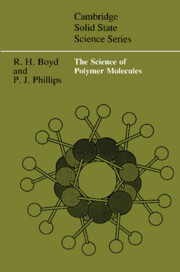Book contents
- Frontmatter
- Contents
- Preface
- 1 Polymerization: an overview
- 2 Molecular weight and molecular weight distribution
- 3 Molecular weight determination
- 4 Polymerization: kinetics and mechanism
- 5 Three dimensional architecture: conformation and stereochemical configuration
- 6 The statistical behavior of conformationally disordered chains
- 7 The interacting bond model for the average properties of coiling chains
- 8 Rubber elasticity
- 9 Solutions
- References
- Index
9 - Solutions
Published online by Cambridge University Press: 29 October 2009
- Frontmatter
- Contents
- Preface
- 1 Polymerization: an overview
- 2 Molecular weight and molecular weight distribution
- 3 Molecular weight determination
- 4 Polymerization: kinetics and mechanism
- 5 Three dimensional architecture: conformation and stereochemical configuration
- 6 The statistical behavior of conformationally disordered chains
- 7 The interacting bond model for the average properties of coiling chains
- 8 Rubber elasticity
- 9 Solutions
- References
- Index
Summary
The ability of polymers to dissolve in various media has great practical importance and can be of either positive or negative benefit. Processing of polymers is often aided by forming solutions but formed polymers in use would most often benefit from being impervious to the environmental effects of potential solvents. Solutions also form an important arena for the characterization of polymers. For example, the various means for molecular weight determination rely on solution measurements. Thus there is good reason to understand the factors governing solubility and to understand the molecular organization of solutions.
Solutions in general, not just polymer solutions, are obviously of high importance and a great deal of attention has been fixed on understanding them. In any such endeavour it is very useful to have a simple theory that conceptually encompasses many of the phenomena observed even if it is not necessarily quantitatively accurate. That role for solutions of simple organic molecules has been filled by the ‘regular solution’ model. In the case of polymer molecules their long chain connectivity requires significant modification of the regular solution model. Thus an appropriate first task here is briefly to review the theory of regular solutions and then to introduce the Flory-Huggins modification for polymer solutions.
Regular solutions of simple non-electrolytes
The regular solution model is based on assuming the spatial disposition of two kinds of molecules about each other in a two-component mixture is random and separately evaluating the energy and entropy of mixing on this basis.
- Type
- Chapter
- Information
- The Science of Polymer Molecules , pp. 330 - 396Publisher: Cambridge University PressPrint publication year: 1993



